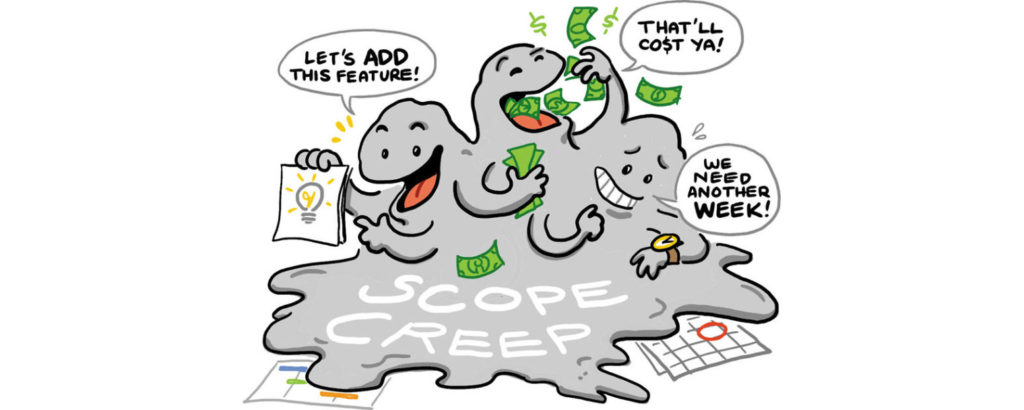Enterprises roll out projects to deliver new and innovative solutions for its stakeholders. But not all projects meet their desired outcomes. Only about 29% of projects succeed. Projects fail to meet the business goals or stakeholder presumptions for several reasons. Here are the top reasons for IT project failure.
1. Inadequate Project Planning
As the adage goes, “failing to prepare is preparing to fail.” Preparations manifest in a coherent plan.
Selection of the wrong project development approach could itself lead to project failure. Both the major approaches – traditional waterfall approach and the in-favour agile approach, have pros and cons. Enterprises often make the mistake of looking at the benefits in isolation. Select the approach most suited for the business and the project on hand.
Every IT project has three constraints: time, budget, and scope. The waterfall approach keeps scope and time fixed, and the budget flexible. The agile approach keeps time and budget constant, with scope flexible. Agile allows teams to shift priorities as needed so that teams could prioritise the most pressing business needs. But the waterfall approach may suit some enterprises or projects.
Even when enterprises get it right on the approach, they may fail to frame end-goals, leading to a loss of focus. Have clear-cut goals, fix the team members, and schedule the workload. Set key milestones and specific deliverables for each member of the team.
2. Not Articulating Requirements of Goals in IT Projects
Bad requirements are the number one reason for project failure. Planning does not atone for not understanding the requirements. A sound approach and a well-laid out plan are useless if the selected goals do not meet the intended requirements of the project.
Many project managers focus on the technical details, remaining oblivious to the business value. They proceed without a definite link between the project goals and enterprise priorities. A classic example is the failure of Apple Lisa. Apple launched Lisa positioning business customers. It flopped despite best-in-class project planning and execution, as IBM PCs arrived at a lower price.
Involve stakeholders when articulating the requirements upfront to avoid requirement-goal mismatch.
3. Not Catering for Scope Creep

Scope creep is changing requirements at the execution stage. When the project keeps changing over its lifecycle, plans go awry. The budgets shoot through the roof, workloads change, schedules go for a toss, and delays become the norm. Matters descend into roadblocks, miscommunication, dissidence, and project failure.
Yet, today’s fluid business environment may warrant changes midway. Predict changes and make allowances for scope creep in the initial project plans. Provision extra budget and time. Be flexible and have modular plans in place. Revise plans proactively, when the business environment changes.
4. Not Arranging for the Required Resources Upfront
Successful project execution requires sound tools and techniques. Developers, testers, and others need adequate hardware and software. Many enterprises do not budget for adequate infrastructure and resources and pay the price in project failure.
The nature and quantity of resources depend on the size and scope of the project. Delays occur when the team has to deal with the learning curve of new techniques along with their usual project duties.
5. Failing to Anticipate Risks in IT Projects
Poor or no risk management derails many projects.
Unexpected happenings can inflict any project. Instances include:
- Loss of key members of the development team,
- the enterprise pulling the plug on finances because of fund crunch,
- a breakthrough in technology rendering the project tools obsolete, and more.
Failure to establish proper risk governance for the project increases the chances of IT project failure.
Successful project managers apply techniques such as Monte Carlo analysis to manage risks. Monte Carlo analysis offers a range of probabilities and outcomes for different scenarios.
Develop a formal assessment process for failing projects. Institute an assessment team with members from the involved stakeholders.
6. Poor User Engagement
Projects fail if end-users do not accept it. Whether the project deliverables are useful is beyond the point.
Many project development teams work in ivory towers. Successful project managers engage and involve the users during the project life- cycle. Take their feedback and suggestions. Involve them in the development process. As far as possible, take inputs from end-users at each stage, and let end-users test the product.
Some project managers make the mistake of going to the other extreme. Do not compromise on UX or essential business needs such as security, for populist considerations. Successful projects reconcile user needs and preferences with business requirements.
Consider the case of Qantas, Australia’s national airline. Failing to engage the end-users forced the company to abandon a costly IT project and set back developments by three years. In 2008, the airline cancelled its $40 million Jetsmart projects to build a parts management system. Aeroplane mechanics refused to use the poorly designed and complicated solution. Instead of asking the mechanics what they needed, the project team developed what they thought was appropriate.
7. Ineffective Collaboration and Communications

Failing to provide a robust collaborative and communication platform leads to confusions. Have strict version control systems in place. Have a formal system in place to upload project updates, and discuss the progress.
Consider HealthCare.gov, the U.S. government project to build a website for uninsured individuals. The site drowned due to the sheer number of users. Project managers underestimated the user base, owing to improper feedback.
8. Failure of Human Resources
It is easy to replace lost technology. But it is very hard to replace skilled talent. Artificial Intelligence has a long way to go before it can replace human brains, if ever. Often, a critical member of the team quitting the company has been the sole reason for project failure.
Equally disastrous is having incompetent team members or team members with the wrong skills. If a project requires a skilled Java programmer and the candidate appointed do not have such skills, the project ends in a logjam. Project managers without sound leadership or crisis management skills can also doom the project.
Team member procrastination goes hand-in-hand with poor project management. Recruiting people only on their technical skills may be counterproductive. Consider their ability to remain organized and the extent of their attention to detail.
Leaving the team to fend for itself is another mistake. Manage and motivate people to extract optimal performance. Give them ownership of their work, to increase commitment.
9. Failing to Overcome Dependency Delays in IT Projects
Large IT projects involve multiple development teams with several dependencies. The dependencies may be other internal teams or vendor teams. If any such dependency team cannot deliver on time, or as per expectations, it can derail the project. Dependency delays contribute to 23% of project failures.
Consider Boeing’s Dreamliner project. In 2004, Boeing launched its Dreamliner project for a quieter, and fuel-efficient aeroplane. Outsourcing the design and manufacturing delayed deliverables and led to poor documentation. These setbacks delayed the project by four years and overshoot the budget to twice the original estimate.
When creating dependencies, make sure the other team is on the same page and have the competencies to do the job.
Project failure leads to a waste of time, money, effort, and opportunity costs. There is the added list of loss of reputation and demoralized workforce. The businesses may never recover from such a disaster.











